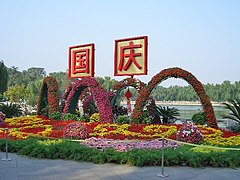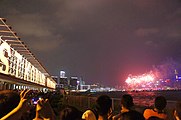National Day of the People's Republic of China
| National Day of the People's Republic of China 中华人民共和国国庆节 | |
|---|---|
 Flower garden at Beihai Park in 2004 The signboards read 「国庆」 (guóqìng; literally "national celebration"), i.e. "National Day". | |
| Also called | China Day, China's birthday, PRC Day, 10-1 |
| Observed by | People's Republic of China including Hong Kong and Macau |
| Type | Historical, cultural, nationalist |
| Significance | The day of the proclamation of the establishment of the People's Republic of China in 1949 |
| Celebrations | Festivities, including fireworks and concerts (a grand military parade every several years) |
| Date | 1 October |
| Next time | 1 October 2022 |
| Frequency | Annual |
| First time | 1 October 1949 |
| National Day of the People's Republic of China | |||||||||||||||||||||||||||
|---|---|---|---|---|---|---|---|---|---|---|---|---|---|---|---|---|---|---|---|---|---|---|---|---|---|---|---|
| Simplified Chinese | 国庆节 | ||||||||||||||||||||||||||
| Traditional Chinese | 國慶節 | ||||||||||||||||||||||||||
| Literal meaning | national celebration holiday | ||||||||||||||||||||||||||
| |||||||||||||||||||||||||||


National Day (Chinese: 国庆节; pinyin: guóqìng jié; lit. 'national celebration day'), officially the National Day of the People's Republic of China (中华人民共和国国庆节), is a public holiday in China celebrated annually on 1 October as the national day of the People's Republic of China, commemorating the formal proclamation of the establishment of the People's Republic of China on 1 October 1949. The Chinese Communist Party victory in the Chinese Civil War resulted in the Kuomintang retreat to Taiwan and the Chinese Communist Revolution whereby the People's Republic of China replaced the Republic of China.[2][3]
Although it is observed on 1 October, another six days are added to the official holiday, normally in lieu of the two weekend breaks around 1 October, making it a de facto public holiday comprising seven consecutive days also known as Golden Week (黄金周; huángjīn zhōu) with specifics regulated by the State Council.[4] Festivities and concerts are usually held nationwide on this day, with a grand military parade and mass pageant event held on select years.[A] The parade held on 1 October 2019 marked the 70th anniversary of the People's Republic of China.
History[]
The Chinese Communist Party (CCP) defeated the incumbent Kuomintang (KMT) nationalist government of the Republic of China in the Chinese Civil War that took place from 1927 to 1950 except for a brief alliance against Japan in the Second Sino-Japanese War. In its aftermath, the internationally recognized government of China withdrew to the island of Taiwan, previously a prefecture of the Qing Empire that was ceded to Japan under its colonial rule from 1895 to 1945.
The People's Republic of China was founded on 1 October 1949, with a ceremony celebrating the forming of the Central People's Government taking place in Tiananmen Square in its new national capital of Peking (previously Peiping) on the same day that year.[6] The first public parade of the new People's Liberation Army took place there, following the address by the country's first Chairman Mao Zedong officially declaring the formal establishment of the Republic. The Central People's Government passed the Resolution on the National Day of the People's Republic of China on 2 December 1949, and declared that 1 October is the National Day.[7]
National celebrations[]
This section needs additional citations for verification. (September 2020) |
National Day marks the start of the only golden week (黄金周) in the PRC that the government has kept. Removing one of the Golden Weeks caused controversies when it happened in 2007.
The day is celebrated throughout mainland China, Hong Kong, and Macau with a variety of government-organized festivities, including fireworks and concerts, as well as sports events and cultural events. Public places, such as Tiananmen Square in Beijing, are decorated in a festive theme. Portraits of revered leaders, such as Mao Zedong, are publicly displayed.[8] The holiday is also celebrated by many overseas Chinese.
Wreath-laying ceremony at the Monument to the People's Heroes[]
From 2004 to 2013, a national wreath-laying ceremony was held on National Day in Tiananmen Square following the flag raising ceremony on years with no parades. The ceremony was centered on the Monument to the People's Heroes, built in 1958 in remembrance of the millions of Chinese who perished during the long years of national struggle. Beginning in 2014, they have been held on a new holiday, National Memorial Day, set on the eve of National Day, 30 September, and is presided by the General Secretary of the Chinese Communist Party (China's paramount leader) and other party and state leaders.
Publication of the National Day Honors List[]
An old tradition revived in the 2019 is the publication of the "National Day Honors List" by the State Council as a measure of national gratitude and recognition of services rendered by a number of local and foreign-born individuals in charitable actions, as role models to the Chinese people, in contributing to the growth of the economy and the nation's sporting prestige, in fostering diplomatic relations with countries of the world and preserving and promoting Chinese culture and the arts by their appointment as recipients of national medals and national honorary titles in the name of the state. The President and General Secretary is the presiding officer of the awarding ceremony, which usually is held in the Great Hall of the People days before National Day itself.
National flag-raising ceremony[]
For many years, the 6 a.m. National Day flag-raising ceremony is the more important act on years without any anniversary parades. Held at the Tiananmen Square, since 2017 the Beijing Garrison Honor Guard Battalion's Color Guard Company is present for the ceremony with the National Marching Band of the PLA. Until 2016 the Beijing People's Armed Police units provided men for the ceremonial color guard. The ceremony is open to the general public and tourists and is widely televised and streamed online for viewers at home and aboard. At the end of the ceremony, doves are released.
National civil-military parade[]

The special civil-military parade of the People's Liberation Army, People's Armed Police and the Militia together with representatives of the people of all walks of life including the Young Pioneers of China is held on special years in the morning of National Day itself. It has since 1984 been televised on China Central Television since 1984 (and broadcast around the world from that year as well via satellite and cable television), is a key highlight of the national celebrations in Beijing.[9] The parade was annual from 1950-59 and terminated until 1984. There was a parade planned for 1989 but was cancelled following the June 4th crackdown. Since 1999, parades have been held on National Day every 10 years.[10][11]
The parade is overseen by the paramount leader in his political duty as General Secretary of the Chinese Communist Party and constitutional mandate as President of the People's Republic of China, as well as military leadership as the Chairman of the Central Military Commission.
The paramount leader is accompanied on the rostrum on the Tiananmen Gate by:
- Premier of the State Council of the PRC (master of ceremonies)
- Members of the National People's Congress and the Chinese People's Political Consultative Conference
- High ranking officials of the CCP Politburo Standing Committee and the other departments under the CCP Central Committee
- State Councilors
- Retired leaders
- Members of the diplomatic corps
Gallery[]

Military vehicles were shown in the celebration of the 50th anniversary
2004 National Day celebration in Tiananmen Square, Beijing

2008 National Day celebration in Macau

2012 National Day celebration in Hong Kong
See also[]
- National Day
- National Day of the Republic of China
- History of the People's Republic of China
- 60th anniversary of the People's Republic of China
- 70th anniversary of the People's Republic of China
Notes[]
References[]
- ^ Fu, Ying (16 July 2008). "China at 60: Nostalgia and progress". The Guardian. Archived from the original on 8 September 2013. Retrieved 30 April 2011.
- ^ "Flag-raising ceremony held for China's National Day celebration". Xinhua News Agency. 1 October 2009. Archived from the original on 4 October 2009. Retrieved 30 April 2011.
- ^ Westad, Odd (2003). Decisive Encounters: The Chinese Civil War, 1946–1950. Stanford University Press. p. 305. ISBN 978-0-8047-4484-3.
- ^ "国务院办公厅关于2019年部分节假日安排的通知" [Notice of the General Office of the State Council on Some Holiday Arrangements in 2019]. 4 December 2018. Archived from the original on 18 May 2019. Retrieved 29 September 2019.
- ^ 新中国历次大阅兵 [New China's previous grand military parades]. gov.cn. Xinhua News Agency. 21 August 2009. Archived from the original on 27 December 2009. Retrieved 26 September 2019.
- ^ "China National Day: October 1st, Golden Week". travelchinaguide.com. Archived from the original on 20 April 2016. Retrieved 7 April 2016.
- ^ "National Day celebrated across China". Xinhua News Agency. 1 October 2009. Archived from the original on 4 March 2016. Retrieved 30 April 2011.
- ^ "China celebrates with elaborate display of power and ideology". The Irish Times. 2 October 2009. Archived from the original on 17 October 2012. Retrieved 30 April 2011.
- ^ "The history of the People's Republic of China – through 70 years of mass parades". Archived from the original on 1 October 2019. Retrieved 8 October 2019.
- ^ "1960年至1983年为什么没有国庆阅兵". Archived from the original on 8 October 2019. Retrieved 8 October 2019.
- ^ Hung, Chang-tai (2007). "Mao's Parades: State Spectacles in China in the 1950s" (PDF). The China Quarterly. 190 (190): 411–431. doi:10.1017/S0305741007001269. JSTOR 20192777. S2CID 154319855. Archived (PDF) from the original on 13 August 2017. Retrieved 16 October 2019.
External links[]
| Wikimedia Commons has media related to National Day of the People's Republic of China. |
- US-China Institute: 60 years of celebrating the creation of the people's republic
- images of the 2009 celebration
- Parts 1 2 3 and 4 of a documentary on the history of the Chinese National Day Parade
- The National Day Parade Official Website (2009 version)
- Public holidays in China
- National days
- October observances
- Autumn events in China
- Republic days





